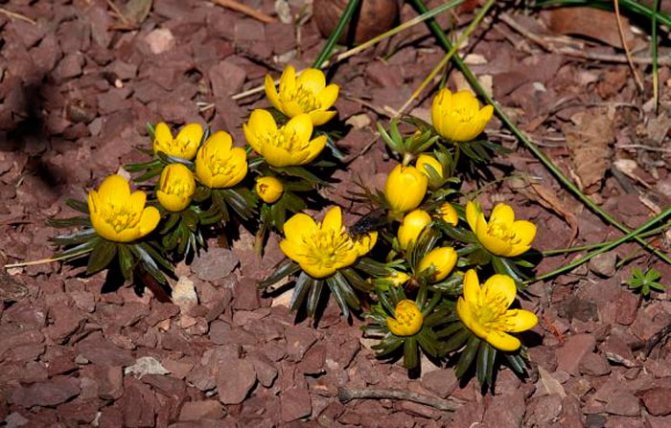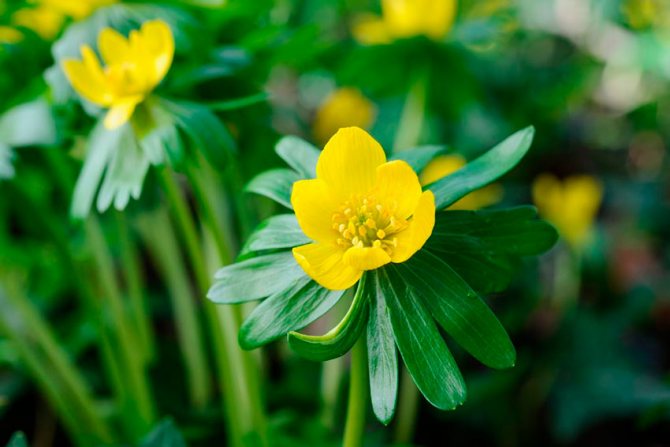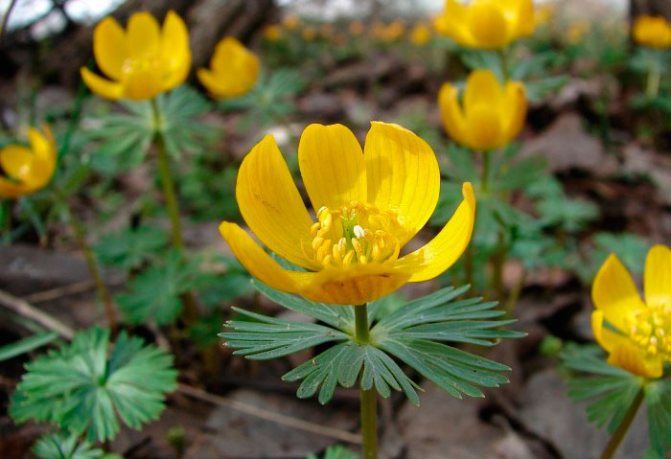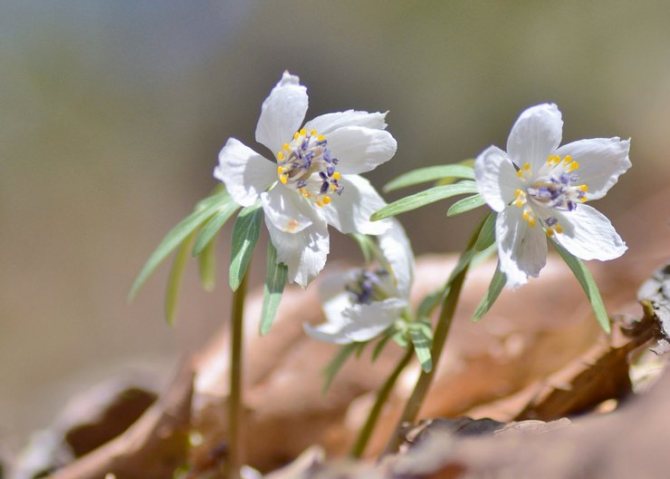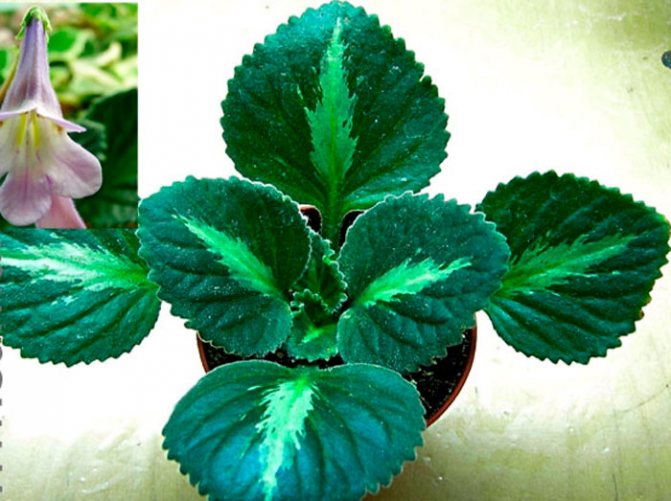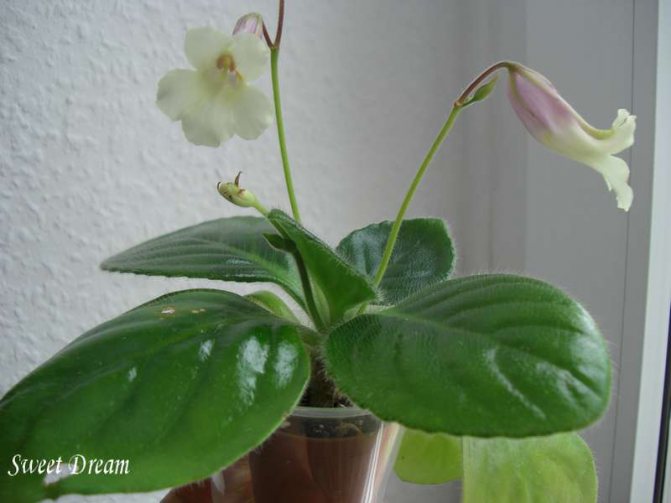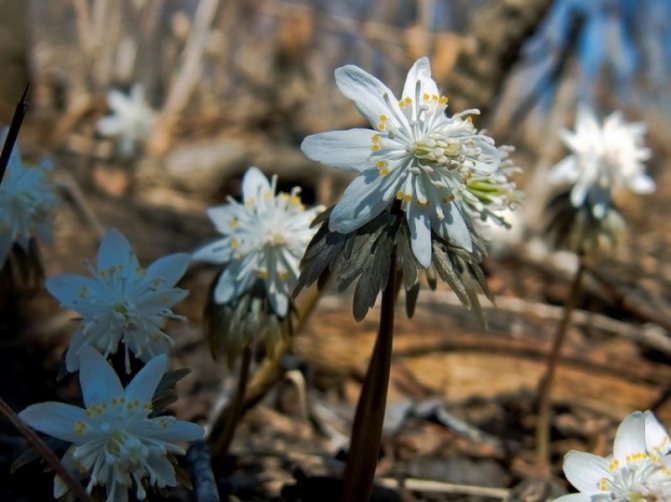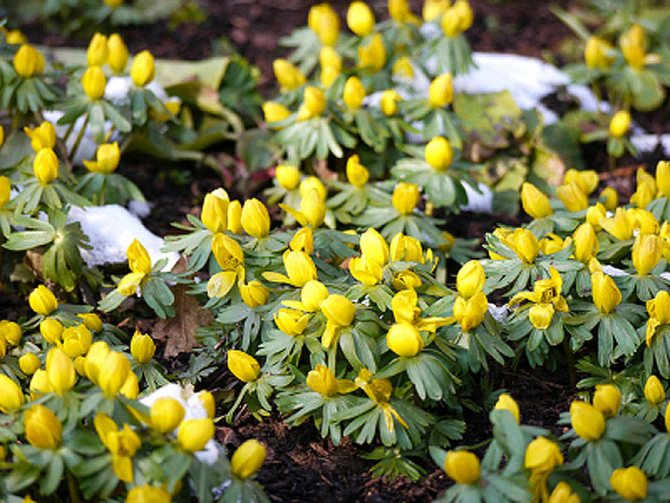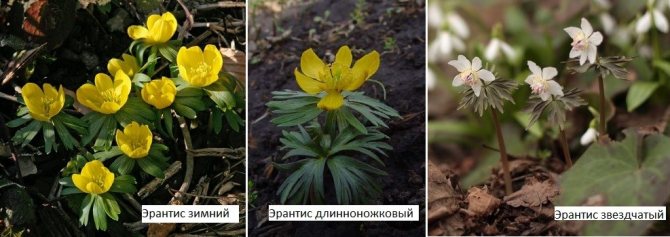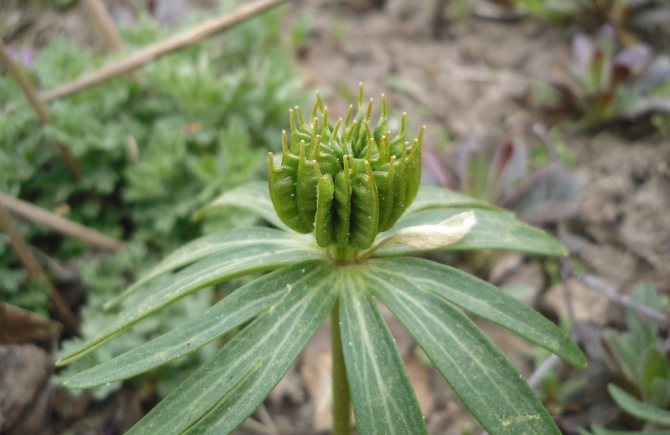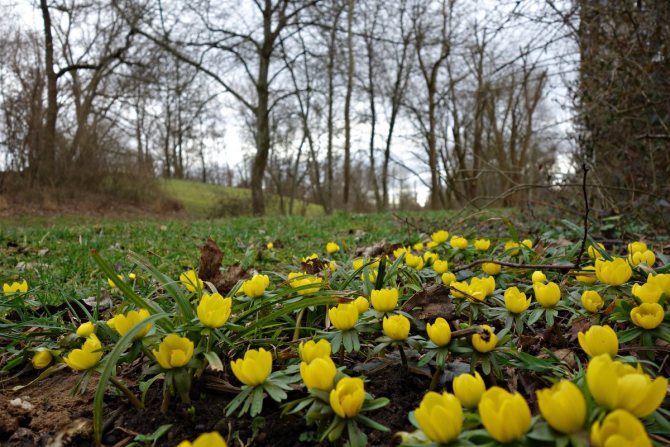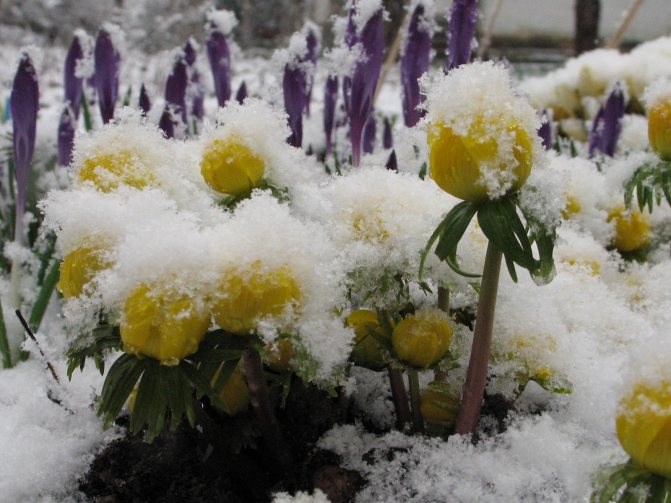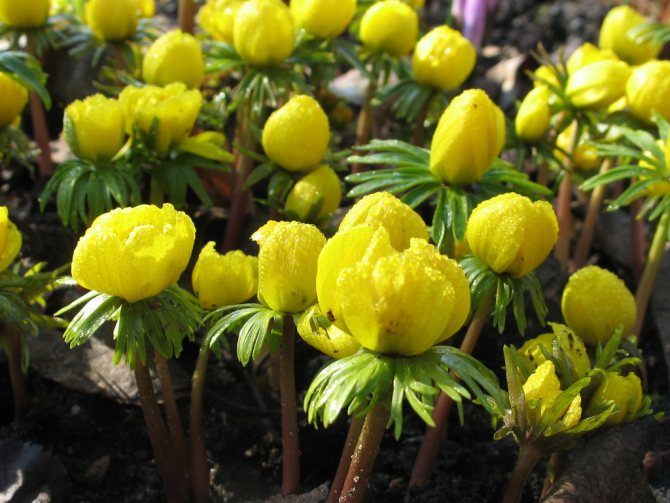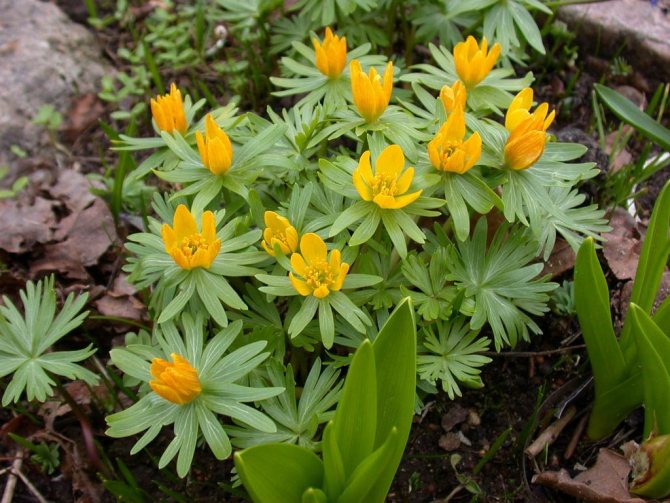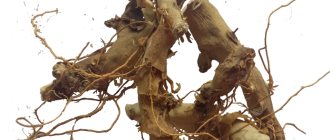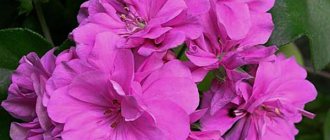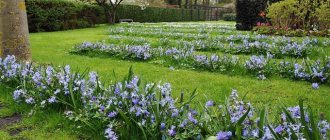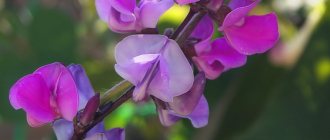The flowering perennial plant Eranthis, also called a spring plant, is a member of the buttercup family. This genus unites only 7 species. Erantis is translated from ancient Greek as "spring flower". In the wild, these plants can be found in southern Europe and Asia. In China, there are 2 species that are endemic, one is considered endemic to the Japanese island of Honshu, and another is the Siberian mountains. The typical species of spring came to North America from Europe, and today it can be found there even in natural conditions. Cultivated since 1570
Types and varieties of spring or erantis
Erantis (spring) has several species.

Vesennik star-shaped sonata (Eranthis stellata) grows in the Far East, blooms with white flowers. For best growth, plant well in moist soil with humus. In natural conditions, it grows in forests and shady areas. Blooms in April.


Vesennik stellata (Eranthis stellata)
Vesennik long-legged
Vesennik long-legged, another name for long-stemmed (Eranthis longistipitata) - originally from Central Asia. It justifies its name, since it has a stem up to 40 cm high. It is very similar in appearance to wintering erantis, but differs in smaller size. Blooms in May.
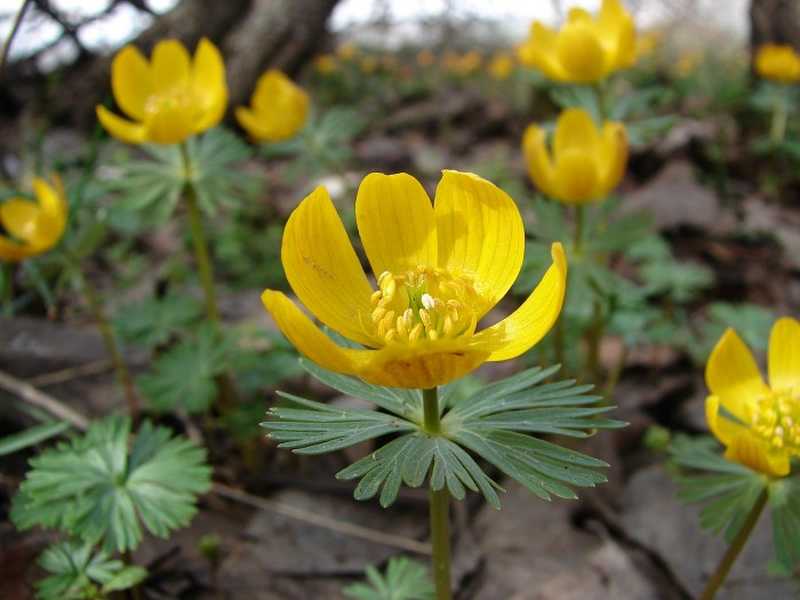

Long-legged springflower (Eranthis longistipitata)
Spring spring
Wintering or wintry spring (Eranthis hyemalis) is native to southern Europe. Usually grows under deciduous trees in forests or on mountain slopes, in alkaline soils. It blooms very early, appears almost from under the snow. Flowers are yellow. It reaches a height of about 10 cm.


Wintering or wintering spring (Eranthis hyemalis)
Erantis cilian (Eranthis cilicica) is a native of Greece and Asia Minor. The plant has large flowers. This species is less resistant to frost. It begins to bloom 2 weeks later than other species and the flowering is not too active.
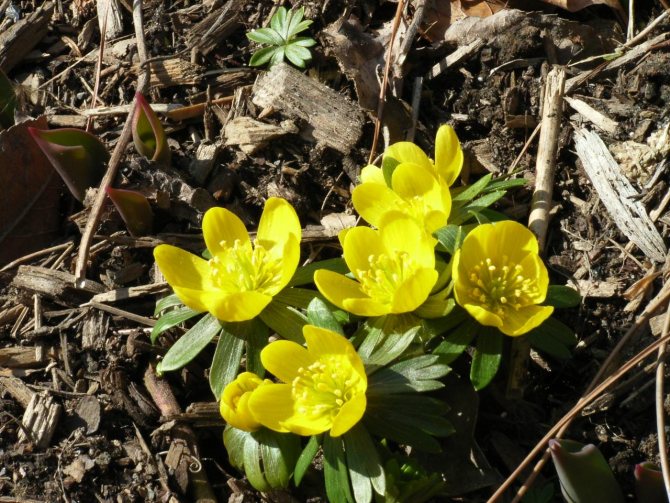

Wintering or wintering spring (Eranthis hyemalis)
Erantis Siberian (Eranthis sibirica) grows in Western and Eastern Siberia. It begins to bloom in May, the flowers are white. This species is most widespread as a cultivated plant. Rare terry species are bred in the UK.


Erantis Siberian (Eranthis sibirica)
Erantis pinnatifida (Eranthis pinnatifida) is distinguished by elegant white flowers. Stamens have an unusual bright purple color. Grows on non-acidic soils. Of interest to container growers.
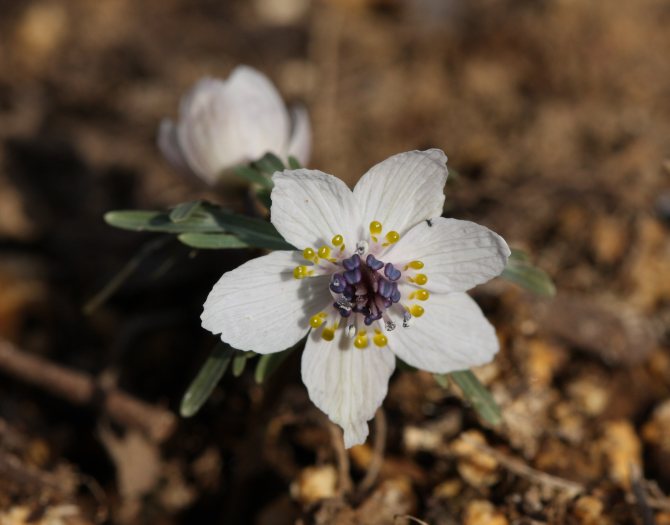

Erantis pinnatifida (Eranthis pinnatifida)
Spring spring species rare in culture
Among the rare species of erantis, the spring flower of Tubergen (Eranthis tubergenii) is of great interest. Breeders bred this variety by crossing the winter spring and the Kiliya spring. Height ranges from 8 to 20 cm. It stands out with leaves of a bronze ebb and long flowering. It is noteworthy that after flowering, the plant leaves no seeds. The most popular variety is Guinea Gold with yellow flowers.
Vesennik Tubergen (Eranthis tubergenii)
Photo gallery of views
Reproduction planting and caring for erantis
Reproduction of erantis from seeds is most often used, since the process takes too long when propagating with tubers. Vesennik can also reproduce by self seeding. To make it easier to care for the seedlings, the seeds are sown in a box of thin plywood, which is then buried in the ground. This is one of the most popular methods, since after transplanting the plants “do not get sick”. Seedlings appear the next year in spring, and the spring will begin to bloom only in the third year.
In the open field, in natural conditions, the spring plant reproduces by self-sowing.Seeds that fell off in the fall are naturally stratified in winter, in other words, they are kept at a certain temperature. This promotes their growth, and in the spring they sprout at the same time, sometimes at a distance from the mother plant.
To reproduce erantis with tubers, you need to select children over 3-4 years old. The tubers are divided in July, after the top has died. Children are planted in small holes at a distance of 10-15 cm from each other. Planting depth should not exceed 5 cm. Up to 6 tubers can be planted in one hole. Before planting, the hole must be well watered, fertilized from a mixture of humus and ash of deciduous plants.
Landing erantis
It is best to plant a plant in a new place in the fall after collecting the seeds. To do this, you need to prepare the soil in the shady area. During the winter, the seeds are stratified in natural conditions, and in the spring it will be possible to see seedlings that will bloom in the third year. Cultivation and reproduction of erantis is a laborious process, but the first shoots always delight lovers of these plants.
Caring for erantis
Erantis is an unpretentious plant, therefore it does not require special care. In addition, it is a frost-hardy type of spring flowers. In the summer, the spring plant should be well watered to prevent the tubers from drying out. However, the plant does not tolerate standing water, this will lead to the soaking of the root system.
Plants can be transferred outdoors. Landing sites should be selected bright, but without direct sunlight. Certain types of erantis, such as Siberian and star-shaped, can grow in shaded areas.
If the plant is not transplanted, then it grows for 5-6 years, forming dense thickets. By this time, you can prepare a site for a new sowing of the spring.
It must be remembered that spring plants are poisonous; they should be planted away from cultivated plants, especially edible ones. Access to the plant for animals and children should be limited.
Growing and care
Depending on the type, the springs of the above types are frost-resistant. But they can freeze under the ice crust. Forming the first flower and leaf, they are not afraid of spring frosts. When transferring from natural places to open ground of garden and park and adjoining areas, it is necessary to select sunny areas, but without direct burning rays. Erantis Siberian and star-shaped can be located in shaded areas.
Spring plants are unpretentious plants, but they require soil with a sufficient level of fertility, rich in organic matter and moisture. Almost all types prefer alkaline soils, but develop well on neutral soils. They do not tolerate swimming, heavy soils with high water standing. The root system will quickly get wet, leading the plant to death.
Keep the soil free of weeds before closing the leaves and after retiring. Due to the very short growing season, spring plants do not need additional watering. They have enough reserves of winter-spring moisture. Fertilizers are applied to the holes when planting erantis and are not used in the future. Springs do not need feeding.
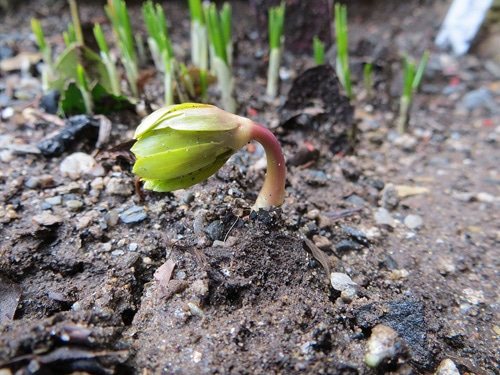

Erantis at the beginning of the growing season
Erantis grows without transplants for 5-6 years, forming beautiful dense low thickets. At home, by this time, a new site is being prepared for transplantation. Erantis are poisonous plants. They should not be planted in places accessible to children and gourmet animals.
Erantis. Description of the plant
The erantis flower may be a little-known plant for you. But once you see how this plant blooms, you will not be able to resist planting it in your area. The name of the flower comes from the Greek words "er" and "anthos", which means "spring" and "flower". Very often you can hear the second name of erantis - spring.
- Erantis can be found in the wild in Southern Europe, Japan. Also distributed in North America and Northern Europe.
- Erantis belongs to the Buttercup family and has about 7 species.
- The stem of erantis reaches a length of about 15 cm.
- Erantis is a low-growing herb.
- The root of erantis has a tuberous shape.
- Erantis leaves are dark green in color and finger-split.
- Erantis flowers reach up to 3 cm in diameter and consist of 5-7 sepals of juicy yellow color.
- The flowering period of erantis begins in the earliest spring, when the snow has not yet melted, and lasts about 14-21 days. In countries with rather mild climatic conditions in winter, erantis can please with flowers as early as January.
- After the flowers have faded, fruits with seeds appear. Seeds are small, brown.
Features of erantis
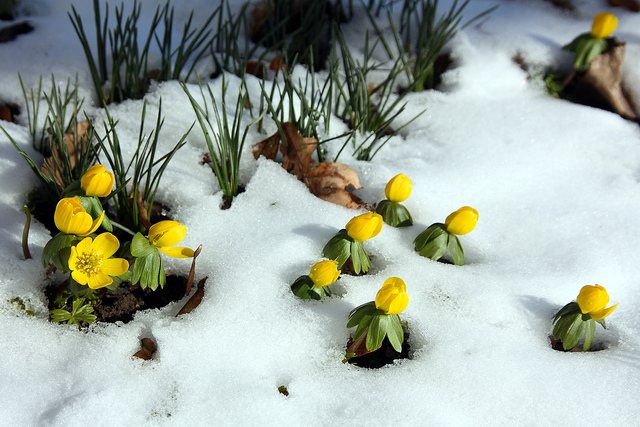

Erantis is a flowering herb with a thickened tuberous root. When flowers appear on the plant, or after flowering, Erantis grows 1 or 2 basal leaf plates of a palmate-divided shape. Peduncles in length can reach 25 centimeters, they bear single flowers. Flowers can be seen open only in the daytime, in rainy weather and in the evening they close, thereby protecting the stamens and pistil from moisture. The whorl is located directly under the flower, it consists of large stem leaf plates, which have a deeply dissected shape. This plant blooms for 15–20 days. The fruit is a flat-shaped accrete leaflet, inside of which are olive-brown oblong-ovoid seeds.
Erantis. Plant varieties
Erantis winter
Erantis winter is also called wintering spring. His homeland is Southern Europe. In the wild, it can often be found in the forests of Greece and Italy. Prefers airy and loose soils. Flowering begins in early spring. The name of the species speaks for itself. Erantis winter begins to grow intensively after the first signs of snow melting. A feature of flowers is their ability to close sepals in cloudy weather. In this way, these lovely yellow flowers are protected from excess moisture. In all their glory, they appear only in sunny and dry weather. At the end of spring, the entire aboveground part of the plant dies off, but the root system continues to develop. The stem reaches a height of up to 15 cm. Erantis winter is able to reproduce both by seed and rhizome. It has been used for decorative purposes for a long time - since the 16th century. Among the most popular varieties are:
- Pauline. A relatively young variety that was bred in England, especially for ornamental cultivation in gardens and plots.
- Orange Glow. This hybrid variety of erantis is also famous for its juicy yellow color of flowers. The country of origin is Denmark.
- Noel Ay res. Vesennik was accidentally discovered by a gardener in England and was named after him. Favorably differs from other varieties of beautiful shape with double flowers.
Erantis winter pleases with its flowering for a short time - about 2-3 weeks. Flowers also attract attention by the fact that right below them there is a "collar" of leaves.
Erantis pinnacle
Erantis pinnacle is noticeably different from its counterparts. Firstly, its flowers have an unusual color. White petals are successfully combined with yellow nectaries and blue stamens. Secondly, erantis pinnacle is known for its endurance. However, gardeners advise against growing it outdoors. This species has reached the greatest popularity in growing in pots, containers, rock gardens. Japan is considered the homeland of this species.
Erantis long-legged
Long-legged erantis is often also called long-stemmed erantis. Its stem can reach a height of 25 cm. The plant is herbaceous with a root system in the form of a tuber. The flowers are bright yellow, small in size - 3 cm in diameter. The flower consists of 6-7 sepals. The flowering period occurs in May and lasts about 14-21 days.It can be propagated by seed. Seeds are spherical and small, enclosed in an elongated fruit.
Erantis siberian
Siberian erantis grows widely in meadows, forest edges, forests of Eastern and Western Siberia. The flowers are beautiful white. The plant begins to dry intensively after the end of the flowering period. Blooms from May to June. Erantis Siberian is a stunted plant with a straight and weak stem.
Erantis stellated
Erantis stellate in natural nature is widespread in the Far East. The flower is so beautiful and charming. that a huge number of plants are used to create bouquets. Erantis grows up to 20 cm. A remarkable feature is the absolutely leafless stem with a lonely snow-white flower at the top. The flower resembles a bright star in shape in the shady forests of the East, which is why the species was so named. It prefers to grow on soils with a high level of moisture, on very shaded edges, under tree crowns in mixed forests.
Erantis Tubergena
Erantis Tubergena is a hybrid variety that was obtained by crossing Erantis winter and Erantis of Cilician. The main feature of this species is that the flowers do not form seeds and pollen. This is what allows you to enjoy a longer flowering of beautiful yellow flowers. Popular varieties are:
- Guinea Gold. The variety was developed in Holland. The plant reaches a height of 10 cm. Flowers reach 3-4 cm in diameter. The advantage of the variety is its long flowering;
- Glory. Also a fairly popular variety from the Tubergen Erantis. Gardeners note its advantages: the large size of the flowers and the pleasant shade of the foliage.
Erantis of Cilician
This species was originally widespread in Greece and Asia Minor, and only then was introduced to Europe. The flowering period of Erantis of Cilician begins 2 weeks later than that of Erantis winter. The species is not very popular among gardeners, because its flowering is not too active. And in terms of frost resistance, Erantis of Cilician is significantly inferior to Erantis winter. A distinctive feature is the color of young leaves - purple with a red tint. The leaves are very strongly dissected into narrow lobes. Erantis grows up to 10 cm.
conclusions
- Erantis, or spring, is a perennial flowering plant of the Buttercup family. Forms buds from the second half of March to the first ten days of April.
- Seed planting can be carried out directly into open ground in the fall. A bright place with a light and aerated substrate is suitable for growing a culture.
- To care for the plant, it is required to control the moisture content of the soil, regularly loosen and weed. Mulching is required only in the northern regions.
- Vesennik is not affected by pests. Among the diseases, only root rotting is dangerous, which occurs with increased soil moisture.
Erantis. Landing
Step 1. Choosing a landing site for erantis
- In their natural environment, erantis grow in very sunny areas or in partial shade under the spreading crowns of trees. When planting erantis on your site, give preference to a place that receives enough sunlight. The best option would be the south or west side of the garden.
- The place where erantis grows must have good drainage. Small plants are fragile enough and can quickly rot when too much moisture.
- Erantis prefer to grow on neutral soils. Experienced gardeners are well aware of the composition of the soil in their area. But for novice fans of growing ornamental plants, determining the type and composition of the soil can be difficult. To facilitate this task, you can use the services of special laboratories, where you need to take soil samples from your site. Experts will reliably determine the composition of the soil. Knowing this information will help you not only in growing erantis, but also other plants on your site. If it turns out that the soil is too acidic, then lime must be added.
- The optimal place for planting erantis will be loamy soil.
- Erantis is not too picky about the nutrient content of the soil. But, if the soil is sufficiently rich in trace elements, then this will have a positive effect on the flowering of this plant.
- For planting erantis, you can choose both an open area and a place under fruit, ornamental trees.
- The soil should be sufficiently light and loose.
- When choosing a site for planting erantis, also avoid low-lying areas. In the spring, a large amount of melt water and an ice crust will accumulate there.


Step 2. Planting erantis
- If you are planting young erantis tubers, then you can soak them for 12 hours in water for better rooting and germination.
- Erantis seeds are advised to be planted in late summer or autumn. You should not bury the seeds in the ground. It is enough to cover with a layer of earth of 1-2 cm.
- Sowing seeds can also be sprinkled with light leafy soil and be sure to water. In the spring, only cotyledon leaves will appear, and erantis will bloom only in the 3rd year after planting.
- Erantis tubers are planted to a depth of about 5 cm and watered.
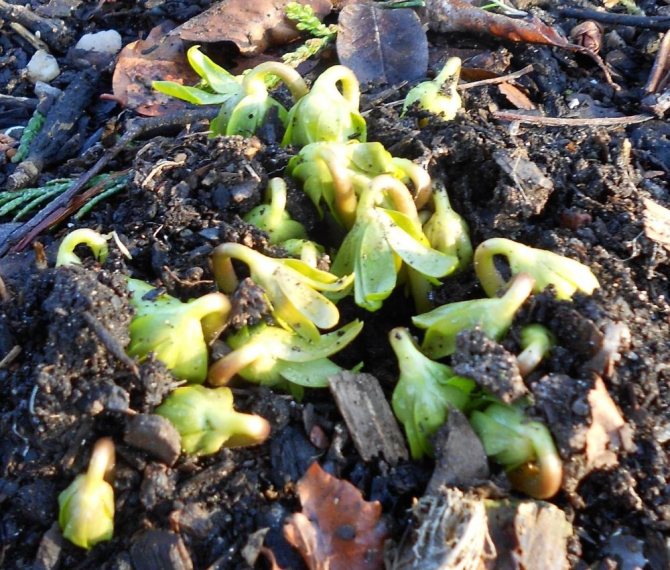

Some gardeners, in order to make it easier for themselves to care for erantis, plant it in boxes, which they then bury. After the erantis have formed tubers from the seeds, they can be transplanted to another place of growth.
Growing erantis from seeds


You can plant spring seeds in autumn and spring. In autumn, the seeds are planted as soon as they are harvested. In the spring, it is necessary to plant only those seeds that have been stratified. To do this, it is necessary in the winter for two months to keep the seeds in wet sand and in the lower compartment of the refrigerator, occasionally spraying the surface. During the autumn planting, such a procedure is not needed, since during the winter cold weather the seeds in the soil will undergo natural stratification.
Erantis well tolerate both the sun and partial shade. Lowlands are best avoided, otherwise the plant may freeze under ice in winter. The soil is slightly alkaline, loose and moist. When planting, it is necessary to deepen the seeds of erantis by at least 5 cm. Seedlings will appear in the next season, but the first leaves will quickly wither. This is considered normal, since in the first year all the forces of the plant are focused on creating small nodules, which will give full-fledged leaves in the next season. In the second decade of August, the seedlings need to be transplanted to a permanent place. The distance between plants should be at least 6-8 cm. After 2 years, the plant should already please with its flowering. If the planting of tubers was postponed to springtime, then they need to be stored in moist peat. This plant reproduces perfectly with the help of self-seeding.
Erantis. Care
Planting and caring for erantis is not at all difficult even for novice gardeners. Follow these guidelines for caring for this flower:
- erantis loves moist soil, but does not tolerate waterlogging. Its small tubers may start to rot. During the active flowering phase, you need to ensure that the soil is always slightly moist. Good drainage will help you prevent excessive waterlogging;
- erantis can do very well without fertilizing with fertilizers. But some gardeners still try to "pamper" the plant with weak solutions of mineral fertilizers. They can be applied before the beginning of the vegetative growth phase, after the end of flowering and in the fall;
- after the erantis has faded, do not allow the growth of weeds in this place. Remember that the tubers of the plant are still underground. Arrange periodic weeding of this area;
- summer time is a kind of dormant period for this "winter" flower. During this time, the frequency and intensity of watering can be reduced. Erantis tolerates mild drought conditions in summer;
- due to the fact that after the aboveground part of the erantis dries up, its tubers remain underground, it is impossible to plant other flowers on the "vacant" place. Plant them side by side.
By adhering to these basic tips for caring for erantis, you will achieve a beautiful and bright bloom in the spring, save and successfully propagate this flower for the next seasons. In the same place, erantis can successfully grow up to 5 years.
Diseases and pests
Erantis is not affected by harmful insects, since it contains a toxin that is dangerous for them. When grown in moist soil or lowland, as well as if the irrigation regime is not followed, there is a risk of developing root rot. An infection can be determined by a slowdown in the growth rate, the appearance of wet spots of a dark color on the stem. For treatment, copper-containing fungicides are used. As a preventive measure, it is recommended to treat the flower bed with wood ash or a 1% solution of Bordeaux liquid twice a year.
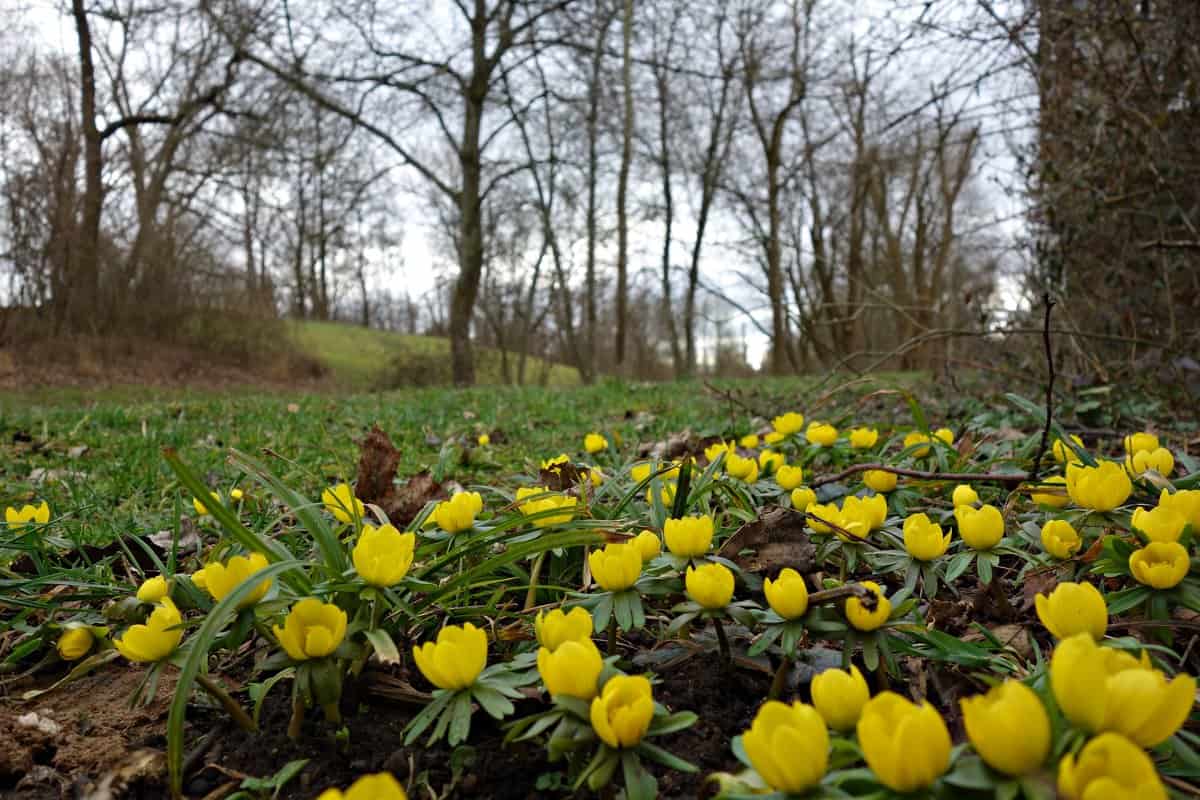

Reproduction of erantis
The most popular breeding methods for erantis are seed and tubers. But this plant can reproduce remarkably and self-sowing. If erantis is already growing on your site, then do not be surprised if you find a new colony of this plant in another, more remote place. This fact can be explained very simply. Small seeds are very often scattered by ants throughout the area.
Reproduction of erantis by seeds
Growing erantis by seed is popular among gardeners. After all, a bag of ready-made seeds can be easily purchased at almost any specialized store for summer residents.
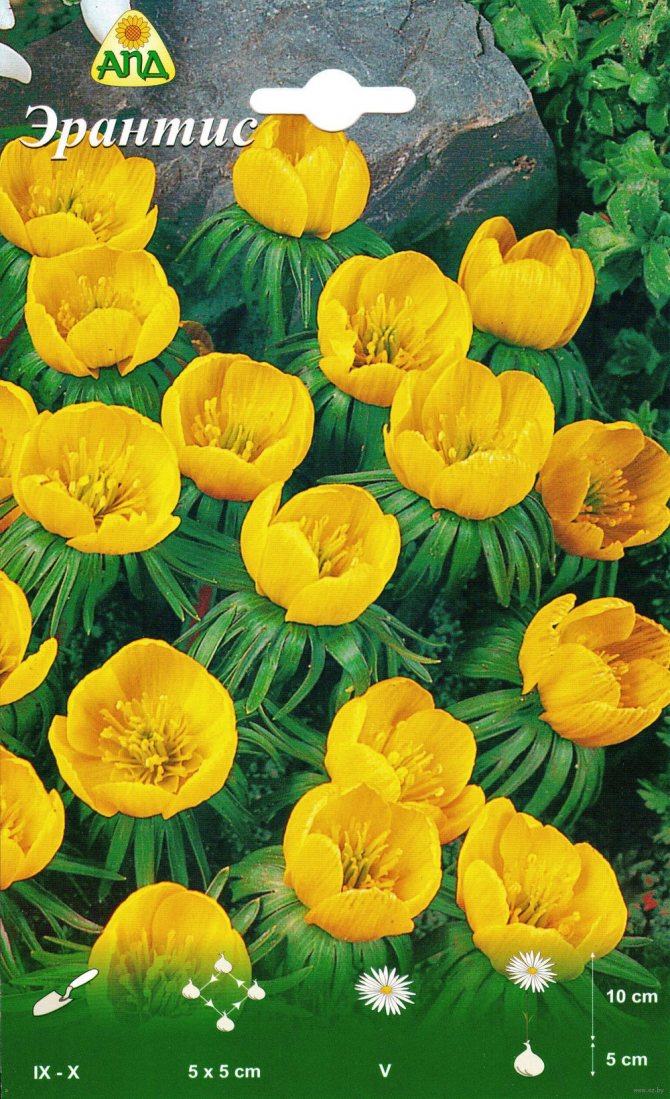

When buying seeds, be sure to pay attention to the expiration date. Inexperienced gardeners may forget about such an important criterion for choosing seed. Seeds with an expired shelf life may not germinate at all, the seedlings will not be friendly. Seeds can be obtained completely free of charge if you or your friends already have erantis growing on the site. After the beautiful yellow flowers have bloomed, wait for the formation of a fruit with seeds. They need to be carefully collected, sifted, dried. You can sow erantis seeds in the following ways:
- sowing seeds of erantis in the spring. For spring planting, seeds must be stratified. If you do not do this, then the seedlings may turn out to be uneven. Stratification should be carried out for 2 weeks at a temperature of 1 to 20 degrees and 2 months at a temperature of about 2 degrees Celsius;
- sowing seeds of erantis in the fall. The most preferred planting time for erantis is autumn. When to expect beautiful flowers in this case? It all depends on the variety you choose. Some erantis in the spring release only cotyledonous leaves, which dry out quickly. It seems that the plant did not accept and died. But this is not the case. Small nodules have already formed and next spring you will enjoy a carpet of yellow flowers. There are erantis varieties that bloom immediately in the second year of planting. They are usually planted in late autumn along with snowdrops. And in the very early spring, your absolutely "bare" garden and plot will sparkle with delicate shades.
Reproduction of erantis tubers
Erantis can be remarkably propagated with tubers. It is worth adhering to the following recommendations:
- if you already have erantis growing, then it is quite possible to dig it up and transplant it to a new place of growth. You can even cut the tubers. The cut points must be sprinkled with charcoal in order to prevent decay;
- erantis tubers are very small. They can very easily be confused with lumps of sand or clay. Experienced gardeners recommend sifting the soil after digging the tubers so as not to lose the planting material;
- erantis tubers do not require deep planting. It will be enough to dig a hole up to 5 cm deep;
- before immersing the erantis tubers in the hole, fertilize it with humus and add a little lime;
- erantis looks especially impressive in group plantings. It is quite possible to place about 5-6 tubers in one planting hole.Maintain a minimum distance of 6-7 cm between plants;
- if you dug up erantis tubers, then it is advisable to immediately plant them in a new place of growth in order to prevent them from drying out. If you cannot plant them right away, store the tubers for a short time in moist peat;
- when breeding erantis, it is important not to forget that even after the aboveground part of the plant has dried, its root system continues to grow and develop. Do not allow excessive growth of weeds in the place where erantis bloomed, do not allow this area to be trampled down. Erantis, which reproduces with tubers, is able to grow in one place for about 5 years.
Care features
Erantis, when grown in the garden, is distinguished by its unique unpretentiousness. The flower does not need regular feeding, pruning and planned transplantation for the winter. The main rule of care is to control the level of soil moisture. Watering is carried out as the surface layer of the soil dries up with a frequency of up to 1 time in 10 days. Water stagnation should not be allowed, so that it can lead to rotting of the root system.
In addition, during the entire growing season, you need to regularly loosen the flower bed and carry out weeding. Mulching is required only in early spring, when there is a threat of night frosts. After flowering, pruning is not carried out, the leaves themselves die off, they are usually left as natural humus. Transplanting to a new place is necessary only after 5-7 years, it is carried out to rejuvenate plants, enhance the decorative effect of flowering.
Erantis in landscape design
Erantis is a spring decorative flower. He is able to become a real "pearl" of your garden, when all other trees, shrubs and flowers have not yet "woken up" from hibernation. It is erantis who is able to create the illusion of a yellow "carpet" in the garden. Why is this plant still not so popular among gardeners? Perhaps not everyone knows with which plants it should be combined, whether it should be combined at all, where to plant, etc. Erantis can be grown both as an independent ornamental plant, and in combination with other plants:
- lungwort;
- snowdrop;
- crocus;
- galanthus;
- miniature conifers, etc.
Erantis will look spectacular almost anywhere in your garden. You can plant this plant in an area under trees, in an open area, between bushes, on an alpine slide, in a stone garden. Once you see charming yellow "suns" from under the snow in early spring, you will not want to part with them. Moreover, planting and caring for erantis is within the power of even novice gardeners.
Use in landscape design
Erantis are classified as decorating plants for rock gardens. They are used for group planting on lawns, in solitary groups under trees. They look great with other early spring and early flowering crops such as snowdrops, lungwort. The combination of yellow and blue creates an unforgettable bouquet. Particularly elegant in this combination are joint plantings with groves (double-leaved scylla), mouse hyacinth, galanthus. Stone gardens, separate clumps on the lawns, covered with a yellow-white carpet of erantis, create an uplifting spring mood. Erantis is a truly magnificent decoration of a spring garden, park, recreation area.
Planting erantis in the ground
How to grow from seeds
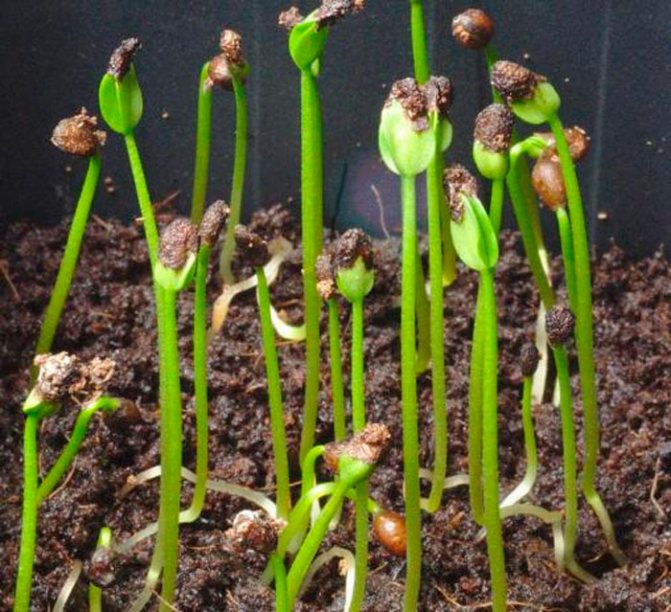

Seeds are sown in autumn immediately after they are harvested. Also, this procedure can be carried out in the spring, however, in this case, the seeds must be stratified, for this they are folded into a container filled with moistened sand, which is removed to the refrigerator on a shelf for vegetables. Do not forget to systematically shake the seeds, as well as moisten the sand. They will stay there for 2 winter months. If you sow before winter, then the seeds will be able to undergo natural stratification.
For sowing, you can choose a well-lit place or something that is located in partial shade under trees or shrubs.It is not recommended to plant such flowers in the lowlands, as they often die there under the crust of ice. It is better to choose a soil for sowing moistened, light, slightly alkaline. The seeds must be buried five centimeters deep into the soil. The first seedlings will appear in spring, however, in the first year, only cotyledonous leaf plates appear in erantis, and after a fairly short time they die off. One should not think that the plants have died, they just have at this time all their forces are directed to the formation of small nodules, which outwardly resemble clay lumps, already next spring they will have a real leaf plate. Do not forget to dig up young plants and plant in a new permanent place, while the distance between the bushes should be from 6 to 8 centimeters, do not forget to do this until the last days of August. Most often, erantis begins to bloom already in the third year of life. In the event that you want to plant the dug nodules in open ground only in spring, then they need to be stored in moistened peat or sand, this will protect them from drying out.
When growing a spring, it should be borne in mind that it is able to reproduce well by self-seeding.
Landing in open ground
After 2-3 years, erantis will already have a well-developed rhizome, and it is at this time that it can be propagated with tubers. It is necessary to make division after the plant has faded, but be in time before the leaf plates die off. The tubers should be removed from the ground along with the rhizome, then the daughter nodules are separated and the rhizomes are divided into parts. Places of cuts must be sprinkled with crushed charcoal, then nodules and cuttings are immediately planted in open soil in a permanent place, they need to be deepened by 5-6 centimeters, while observing a distance of 10 to 11 centimeters between the holes. It is recommended to plant no more than 3–6 nodules in one hole. Before planting the spring, the holes must be watered and one handful of the substrate, which includes broadleaf wood ash and humus or compost, should be poured into each of them.
Landing in open ground
Erantis seeds have a high germination rate, so sowing can be carried out directly into the open ground. It is advisable to choose a bright place for growing this culture, with continuous diffused lighting throughout the day.
The substrate should be light, with moderate moisture and a neutral acid reaction. Sandy loam, loamy or black earth soil is best suited. The recommended sowing time is the first half of September or early October. With spring planting, the growing season increases, there is a risk of death of shoots against the background of recurrent frosts.
Pre-sowing preparation
A flowerbed for growing erantis must be dug up at least 3 months before the start of work. In addition, plant residues and large stones should be removed. Introduce organic matter, for example, humus or mullein at the rate of 3 kg per square meter. meter. The seeds are processed immediately before sowing. To do this, they need to be soaked in warm water for 3-4 hours, and then processed in a solution of potassium permanganate for 30-45 minutes. If you plan to plant in the spring, then the seeds must first be stratified for 2 months in a moist substrate at a temperature of 3 to 5 oC.
Landing technology
Sowing seeds should be carried out in the morning in dry and calm weather. Before starting work, you need to qualitatively loosen the soil, and also moisten it with warm water. Step-by-step landing algorithm:
- Mark the grooves at intervals of 6-8 cm. Deepen by 1-2 cm, pour a layer of wood ash on the bottom.
- Plant the seeds in a row method. Top up with a mixture of sand and fertile substrate.
- Water the landing site. Mulch the soil with sawdust or wood chips in a layer up to 5 cm.
Seedlings appear in 14-16 days, after which they need to be thinned out, leaving the distance between plants up to 4 cm.Gardeners recommend covering the flower bed at night to avoid hypothermia of the sprouts. The rhizome develops within 2-3 years, after which a stable flowering is observed, and the plant itself is ready for transplantation to a new place, reproduction by dividing the tuber.
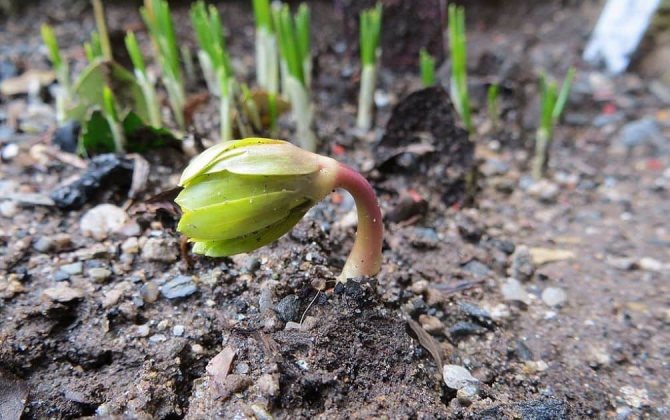

Spring care in the garden
It is not necessary to water erantis, since in the spring time the soil contains a lot of moisture, and in the summer months it has a state of dormancy. In the event that, when planting these flowers, the necessary fertilizers were introduced into the planting holes, then you will no longer have to feed them. All that is required from the gardener is the timely loosening of the row spacings, as well as weeding, which should be done even after the foliage has died.
For 5–6 years, you don't have to worry about replanting the spring, during which time lush, spectacular thickets will appear. However, then it is imperative to dig up the plants, divide and plant. It should be remembered that erantis contains poison, therefore, for planting such a flower, they choose an area in a place that is hard to reach for pets and children.
Diseases and pests
Since this plant contains poison, it is reliably protected from pests and rodents. If the soil contains a large amount of moisture for a long time, then this can cause the development of gray mold on the root system. In order to prevent this, it is necessary to try to remove excess moisture from the soil, because the roots of this plant react extremely negatively to wetting.
After flowering
When the flowering of the spring plant ends, a gradual dying off of its aboveground parts will occur. Then the dormant period will begin at the bush. This plant is highly frost-resistant, so there is no need to cover it for wintering.
Vesennik description
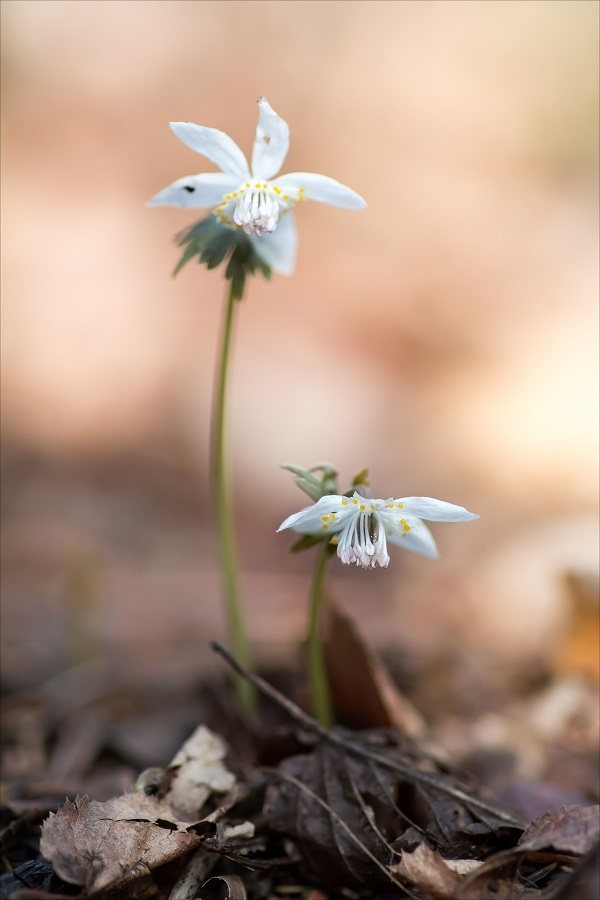

Vesennik stellate or erantis is a perennial ornamental flowering plant. It reaches a height of up to 30 cm. The stem is decorated with large white flowers. Below the petals are purple.
Basal rosette consists of 2-3 leaves that appear in spring. Flowering begins early in April. During flowering, the plant is 3-5 cm high, after - up to 10 cm. Seeds are sown immediately after harvest, in summer or autumn. Therefore, it is better to determine the sowing site in advance. Seedlings are sown for seedlings in February-March. But it should be remembered that when propagated by seeds, the spring plant will bloom only for 2-3 years, so amateur gardeners will have to be patient.
In the garden, it is better for spring workers to take a bright place. They will go well on an alpine slide along with snowdrops. These plants look spectacular both in small groups on the lawn and under trees.
Types and varieties of springnik (erantis) with photos and names
Several types of spring plants are grown in the culture, but only a few of them are very popular.
Erantis winter (Eranthis hyemalis), or winter spring, or winter spring
This species comes from southern Europe. In the wild, it prefers to grow on mountain slopes and in forests under deciduous trees. Underground rhizomes have nodules. The leaf plates are basal. The height of leafless peduncles can be up to 15–20 centimeters. Under the six-petalled yellow flowers, there are very spectacular dissected bracts. Flowering begins in the last days of winter, with flowers rising above the snow cover. Leaf plates grow later than flowers. This spring bloom fades in the last days of May or the first days of June, after which the aboveground part of the bush dies off. This species has a high winter hardiness. Cultivated since 1570 The most popular varieties:
- Noel Hey Res. It has double flowers.
- Orange Glow. This Danish variety was born in a Copenhagen garden.
- Pauline. This garden variation was developed in the UK.
Erantis Siberian (Eranthis sibirica)
Under natural conditions, it can be found in Western and Eastern Siberia.The compact bush is tuberous, when it finishes blooming, it dies off in a short time. Single straight shoots are not very tall. On the bush there is only one basal leaf plate of a palmate-split shape. Single flowers are white. Flowers bloom in May, and the growing season for this plant ends in June.
Eranthis cilicica
In the wild, you can meet in Greece and Asia Minor. This species came to European countries only in 1892. The height of the bush does not exceed 10 centimeters. In comparison with the winter spring in this species, the flowers have a large size. Deep and finely dissected leaf plates have a purple-red color. Stem leaf plates are also dissected into narrow lobes. In comparison with the wintering erantis, the species begins to bloom half a month later, but its flowering is not so active. This plant is moderately hardy.
Erantis long-legged (Eranthis longistipitata)
His homeland is Central Asia. The bush is very similar to the winter spring, but it is not so high. Its height is only 25 centimeters. The color of the flowers is yellow. Blooms in May.
Erantis Tubergena (Eranthis tubergenii)
This hybrid plant was created as a result of crossing Erantis winter and Kiliya. The bracts and nodules in this species are larger, while the flowers do not have pollen, and they do not have seeds, therefore the plant blooms for a relatively longer time. Popular varieties:
- Guinea Gold. The height of the bush is from 8 to 10 centimeters. Dark yellow sterile flowers reach 30–40 mm in diameter. They are surrounded by bracts of a bronze-green color. This plant was bred in 1979 in Holland.
- Glory. The color of large flowers is yellow, and the leaf plates are light green.
Eranthis stellata
The homeland of this kind is the Far East. The height of the bush is about 20 centimeters. Such a herbaceous perennial plant has 3 basal leaf plates. The leafless shoot bears a white flower, the petals of which are painted in a violet-gray color from below. Prefers to grow in shady areas. Flowering begins in April.
Erantis pinnatifida
In this Japanese species, the flowers are white, the nectaries are yellow, and the stamens are blue. This species is quite hardy, but experts advise growing it in a greenhouse.
Botanical description
Erantis are miniature perennials with a height of 5 to 30 cm. They belong to the group of elegant decorative flowering perennial herbaceous plants. The root system is represented by a tuberous-thickened rhizome (1.5-2.0 cm in diameter) of dark brown or black irregular shape, which is an underground stem. Tuberous growths on the rhizome are sometimes called bulbs. These are the beginnings of a future plant. The mother plant dies off at the end of May, and the rhizome tubers form new young plants next spring.
Leaves (usually 1-2) are elegant green in color, on long petioles. The shape of the leaf blade is rounded-oblong, deeply palmate-dissected. Each lobe is ovoid with a serrated edge. Erantis leaves appear almost simultaneously with flowers. Some varieties of spring are ephemeral and die off after 1-2 months with the onset of a dense shade from the leafy crowns of perennial trees.
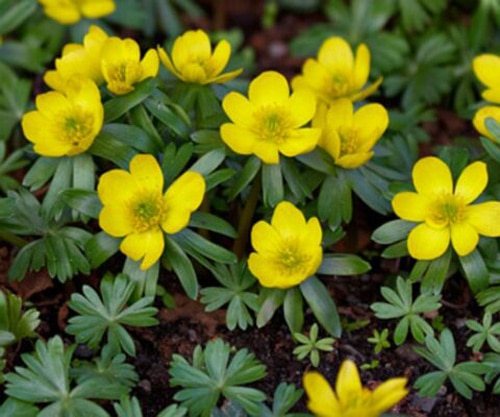

Blooming spring
Flowers are single or group (3-6 pieces on long peduncles), rather large for a miniature bush, up to 3 cm in diameter. The flower is quite original. The size of the flower is created by 5-8 sepals; inside there are corolla petals, small, of the same height with stamens and pistils. In the dark, the petals fold, opening only in bright light. Sepals vary in color from white, light yellow to pale orange. Each flower under the sepals has a green cuff or wrapper, similar to a frill of elongated leaves.The length and shape of the leaves of the wrapper characterizes the type of plant. Spring flowers bloom in late March and early May. Flowering lasts up to 2 weeks. Flowers of early species are not afraid of spring frosts and appear before the snow completely melts.
At the end of flowering, fruits are tied, representing flattened leaflets. Seeds are numerous, oblong-ovate, round, brownish-olive in color.
Under natural conditions, erantis grow in the forests of southern Europe, in Asia, as endemics of some regions of Siberia, the Far East and China, the islands of Japan (Honshu). They were later introduced to North America, where they spread in the wild, and some species are grown as ornamental plants. Southern Europe is considered the birthplace of the type species of winter erantis. Other species are credited with origin in other regions of the world (V. Zvezdchaty - the Far East, V. Cilician - Northern Iran, Afghanistan, Asia Minor, V. Siberian - in Western and Eastern Siberia).
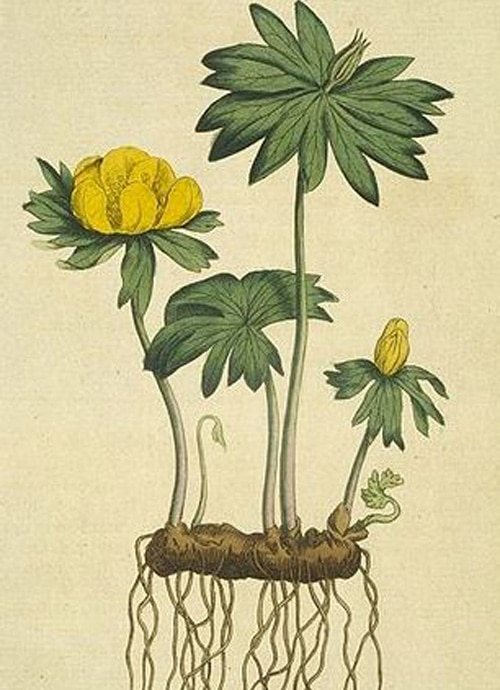

Vesennik (erantis)
ERIANTHUS, or WOOL (ERIANTHUS)
this Cereals
Name: comes from the Greek words "erion" (wool) and "anthos" (flower).
About 45 species of this genus are distributed mainly in savannas in tropical and subtropical zones of the globe, one species is found in the Caucasus and has significant decorative value. Eriantus ravenna -E. Ravennae (L.) Beauv. = E. purpurascens auct.
Inhabits sands, open stony and fine-earth slopes of foothills and low mountains, along rivers and canals, in tugai in the Caucasus, southern Europe, North Africa, Anterior, Central and Southwest Asia.
Perennial plants 1-3 m tall, forming large, usually rather dense tussocks, without creeping rhizomes. Narrow-linear leaf blades, 0.3-1.2 cm wide. Panicles are rather thick, 25-60 cm long. and up to 15 cm wide, more or less silvery from the long silky hairs that envelop the spikelets; the branches of the panicles are rather short, splitting into segments in the upper part along the articulations; spikelets 0.3-0.6 cm long., Brownish, pinkish or yellowish, with one developed flower; the lower floral scales of developed flowers are membranous, at the apex with an awn 0.2-0.6 cm long. 2p = 20, 60. It blooms in late summer and autumn.
A large plant with beautiful panicles. Deserves planting, group and solo, in parks. Used for making dry bouquets. Recommended to test for southern Russia.
Species diversity
Winter or wintering spring Eranthis hyemalis


Winter or wintering spring Eranthis hyemalis photo in the snow
Grows in natural conditions on the slopes of the mountains of Southern Europe. It is characterized by very early flowering. Flowers, located in 2-7 pieces on peduncles about 18 cm long, open only when the weather is clear, protecting their pistils from moisture. Most suitable for the decoration of personal plots.
Types of Erantis, or Vesennik
In total, there are about eight species of erantis.
- Erantis wintering, or winter (Eranthis hyemalis) is native to southern Europe. Grows in forests under deciduous trees, on mountain slopes, on well-drained alkaline soils. It blooms early - right out of the snow. The flowers are yellow.
- Erantis long-legged, or long-stemmed (Eranthis longistipitata) is a species from Central Asia. It resembles wintering erantis, but smaller in size. Blooms in May.
- Eranthis cilicica from Greece and Asia Minor. The flowers are larger than those of Erantis the wintering one. Blooms two weeks later, flowering less active, less hardy.
- Erantis stellata (Eranthis stellata) from the Far East. Flower with white petals. Grows in the shade of mixed forests, on humus and well-moisturized soil. Blooms in April.
- Erantis Siberian (Eranthis sibirica) grows in Western and Eastern Siberia. The flowers are white. Blooms in May.
- Erantis pinnatifida is a white-flowered species from Japan.
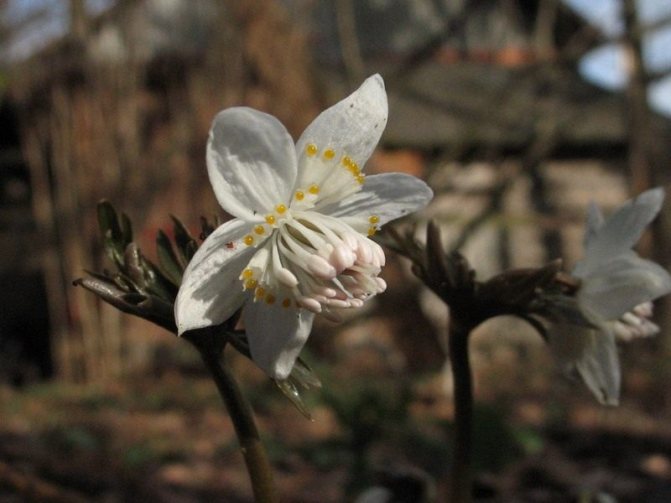

Erantis stellata (Eranthis stellata).
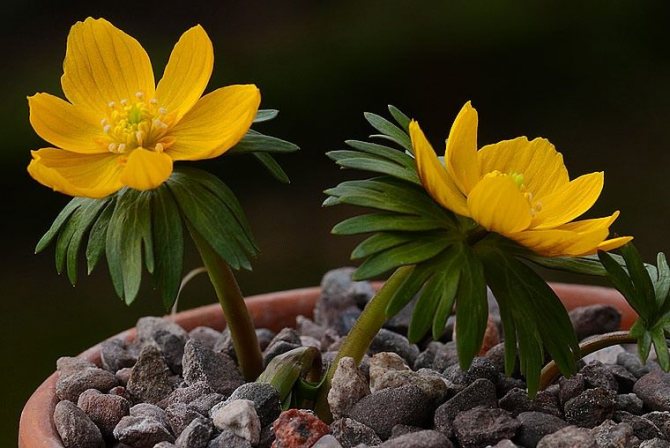

Erantis long-legged, or long-stemmed (Eranthis longistipitata).
Erantis tuber propagation
In the first year after planting, erantis will not be able to reproduce with tubers, for this at least 2 years must pass. Some varieties begin to produce daughter tubers only for 3 years. The process of obtaining a new bulb consists of several stages:
- It is necessary to wait until the spring plant has completely bloomed, but will still retain living leaves. During this period of time, the tubers are dug up.
- Daughter bulbs are separated carefully, taking care not to damage the structure of both parts.
- Young tubers are immediately planted in a place where they will grow constantly.
- You can cut the tubers into divisions, sprinkle the places of separation with crushed coal and plant the plants.
- You need to plant nodules 10 cm apart from each other, a maximum of 6 pieces in one hole. The rhizome is buried at a depth of 6 cm, but not less than 4 cm.
Before planting the spring, the holes need to be watered and seasoned with a mixture of humus, non-coniferous wood and compost. You can achieve a neutral soil pH with ash. Fresh beds are mulched so that moisture is retained in the upper layers of the earth.
to the table of contents
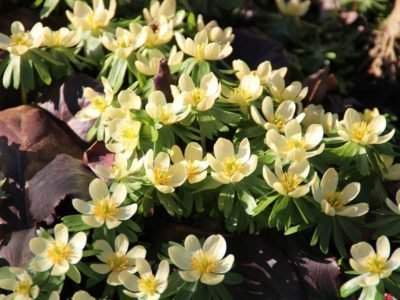

Where can one buy?
You can buy erantis seeds in the following stores:
Storespackagingprice, rub.
| First seeds | 15 pcs | 240 |
| Garden Seeds | 10 pieces | 276 |
| 100sp | 10 pieces | 201 |
| Your garden | 5 pieces | 150 |
Snow carpets made of felt felt


Night violet evening primrose - cultivation of medicinal and decorative perennial
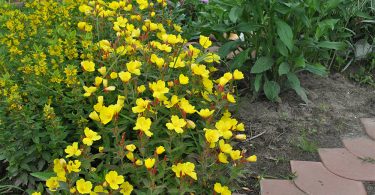

Planting a plant
Gardeners recommend planting the plant in sunny areas. Can also be planted in partial shade. It is preferable to plant it under trees. Better to land in the south or west. It is important to provide good drainage on the site. If there is strong humidity, then rotting of young plants is possible.
When purchasing tubers in specialized stores, you need to pay attention to their quality. Purchases should be made at the beginning of the season, when the choice of planting material is the largest, the goods are not stale. In this case, one should pay attention to the tuber neck, which should be dense, and the surface should be clean and not damaged. The bottom should not have traces of rot, no roots. Since the tubers of erantis are poisonous, it is better for people with allergies to wear them with gloves so as not to irritate the skin. Keep them out of the reach of children and pets.
All plants that reproduce tubers, bulbs like well-drained soil. This also applies to erantis. Therefore, a week before planting, the allotted area must be well dug up. In heavy soil, it is recommended to add fine-grained sand or gravel. Fresh manure must not be added. Before planting, the soil is covered with a rake. On 1 m2, you can scatter a handful of bone meal.
If the soil is not fertile enough, you can gradually apply fertilizer, such as bone meal. The critical moment is the period between the beginning of flowering and the wilting of the leaves. At this time, it is better to apply a phosphate-containing liquid fertilizer.
Popular: Miniature bulbous Ifeion with incomparable aroma
It is recommended to soak tubers in water for twelve hours before planting, which ensures their best germination. They are buried to a depth of five centimeters. Be sure to watered. Regarding watering in the future, it is believed that spring flowering, which includes erantis, does not need to be watered before flowering. After flowering, it is important that the plants retain their green foliage for a long time. In this regard, they need watering in late autumn until the foliage turns brown.
When planting, the seeds are not buried, but lightly sprinkled with earth by 1-2 cm. Seeds should be sown in late summer, autumn. With this method of cultivation, flowering occurs in the third year. Some growers sow seeds in a box. It is dug into the ground.There erantis is located before the appearance of the tubers. And only then the tubers are planted in a permanent place.
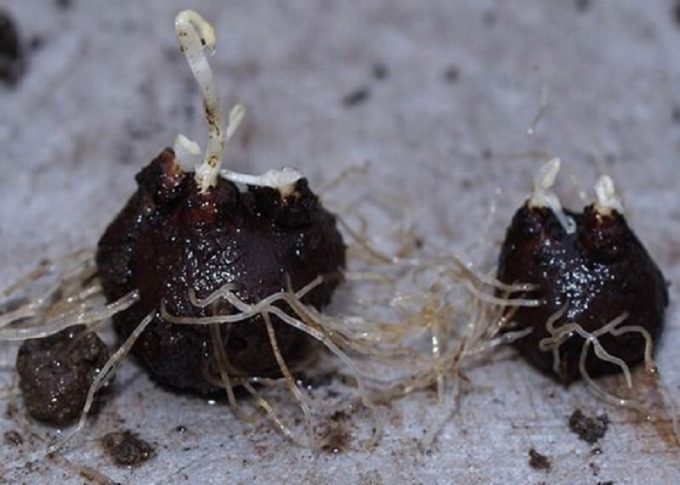

Varieties and types
There are 7 types of erantis that are grown in gardens. One of them can be used as a pot culture, but because of the poisonousness of the plant, keeping it at home, where there are animals and small children, is unsafe.
Winter erantis or wintering spring appeared in Southern Europe. It takes root well and blooms profusely on loose, airy soils. It belongs to the early varieties, tolerates frost normally. Flowering begins at the first thaw or a little later.
Interesting! The main feature of the winter erantis is the closing sepals. In cloudy weather, the buds will be firmly squeezed, protecting from excess moisture.


By the beginning of summer, the ground part of the erantis dies off, but tubers are still developing underground. There are 3 varieties within the group:
- Noel Ay Res - differs in double flowers with a complex shape;


- Pauline - a young variety grown in England for decorating gardens;
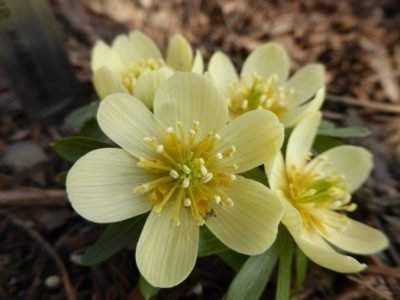

- Orange Glow - a hybrid variety with very bright flowers. On the stem of erantis, 1-3 cm below the sepals, there is a green collar.
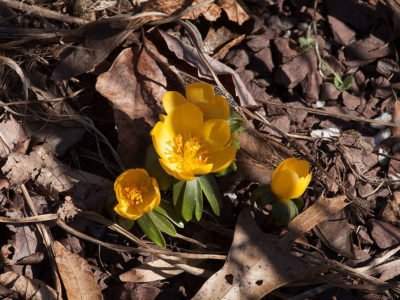

Star erantis in spring, the vastness of the Far East is covered with bright flowers of a star spring. This species is used for bouquets, grows up to 20 cm in height in good conditions. Leaves are completely absent on the stem. Usually found in white.
It got its name from the sepals that make up the shape of the star. Grows on well-moisturized soils in dark forest zones. Star erantis blooms for a very short time - less than 2 weeks.


Peristoncut Springbinder common in the Japanese islands and has snow-white flowers with yellow nectaries and blue stamens - the most unusual type of erantis.
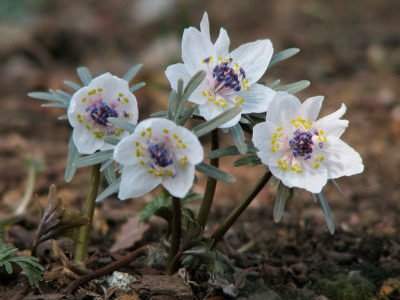

Erantis Tubergena
A hybrid variety that combines the properties of winter and Cilician spring. When planting, it can be seen that the tubers of erantis are very large, and after flowering, seeds do not appear.
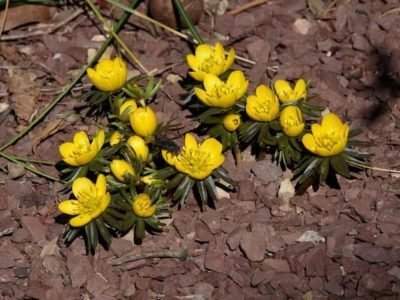

The species belongs to long-flowering, consists of several varieties:
- Guinea Gold - characterized by low stems up to 10 cm, dark yellow buds with a green "collar" and bronze bracts;
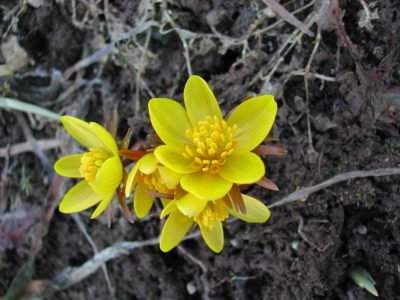

- Glory - has light green stems and leaves, as well as an enlarged shape of yellow buds. Suitable for arranging a summer garden, in combination with other types of erantis prolongs flowering.


Siberian erantis from the name it is clear that the flower in the wild is often found in Western and Eastern Siberia. Large fields are found along the banks of river beds, in high mountain valleys. Can often be seen in snowy fields. Its stems are weak, but beautiful white flowers are located on them. The inflorescences open in May, and in June the plant retires.


Long-legged spring distributed in Central Asia. The height of individual plants reaches 25 cm. It begins to bloom late - in May. The buds are large, bright. By the end of June, it completely fades and forms spherical bags with seeds.


Cilician spring began to spread from the south of Europe and Asia Minor. It begins to bloom 12-16 days later than the winter variety. It is found more in the wild than in gardens due to poor flowering. Not suitable for growing in frost-resistant areas. It differs in the period of the first buds with bright purple petals with a red sublayer. It grows low - up to 10-12 cm.
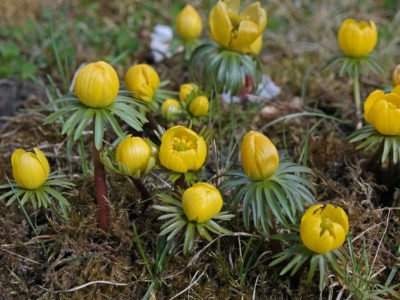

to the table of contents
Reproduction
Seeds that are sown immediately after ripening in early summer. Plants reproduce easily and self-sowing. Immediately after flowering, the tubers are dug up and planted while they still have leaves. It is useful to immerse purchased tubers in water overnight before planting in autumn.
[collapse]
The main characteristics of erantis
Vesennik is a low-growing plant with herbaceous leaves, its height reaches 14-26 cm. It belongs to the buttercup family, and belongs to the group of poisonous flowers.There are at least 7 species of erantis, some of which (for example, lobulata) are little known in Russia.
The root of the plant has a tuberous shape, and the leaves are painted in a rich green color. Their structure is finger-divided, and the flowers consist of 5-7 sepals. The diameter of the spring reaches 3-4 cm. Different varieties have their own shades: multi-colored stamens, white sepals interspersed with pink, pale lemon buds.
Fact! Erantis begins to bloom in early spring, when the snow is still on the ground. Flowering ends in 14-25 days. In southern climates, a plant older than 2 years blooms in January.
After flowering, fruits are formed, which contain seeds. They can be used to breed erantis.
to the table of contents
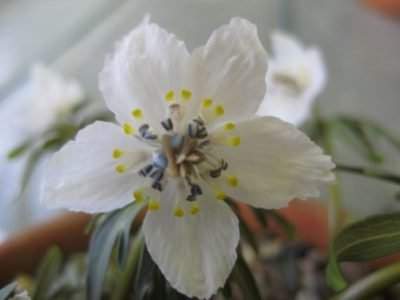

Spring types
5 types of erantis are grown in the gardens.
Winter (E. hyemalis) - cultivated by flower growers since the 16th century. The plant begins to vegetate even under the snow, as soon as the soil thaws slightly. Flowering begins simultaneously with the spring buttercup. The stalks stand bent for several days, and then take an upright position. Stem height up to 15 cm.
A bunch of shiny leaves is located under the flower, which gives the plant an additional decorative effect. The flowers in the open state reach 3 cm. In the shade, the corollas are closed, in the sun they open.
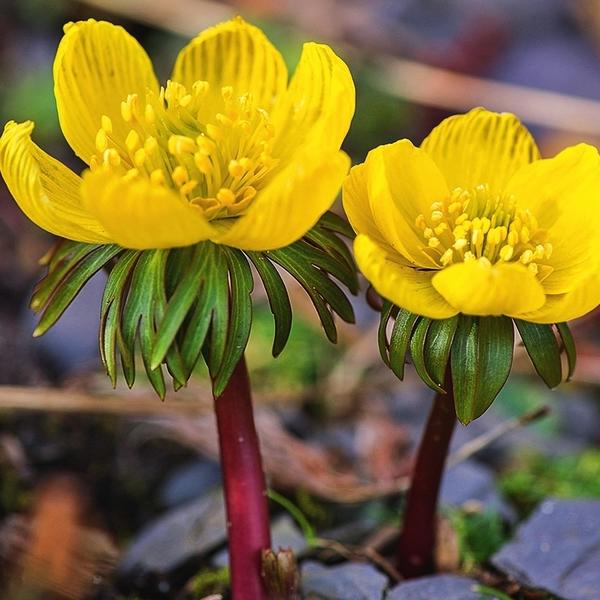

By the beginning of summer, the spring plant dies off, forming only a few daughter bulbs the size of a match head. This number of children is enough for a picturesque curtain to appear in place of one flower in 3-4 years.
Varieties:
- Noel ay res;
- Orange glow;
- Pauline.
Siberian (E. Sibiricas) - found in Siberia, where it prefers riverbeds and forest edges. It is a frequent representative of the flora of mountain meadows and sparse coniferous forests.
The plant is small and fragile, dries quickly, barely having time to bloom. First, a single leaf appears from the soil, divided into 3-5 large parts. Later, in the middle of the stem, an additional leaf blade is formed, composed of several lobes. Flowers bloom one at a time. The color of the corolla is white. Flowering occurs in May, and by the beginning of summer the plant has completely disappeared from the soil surface.
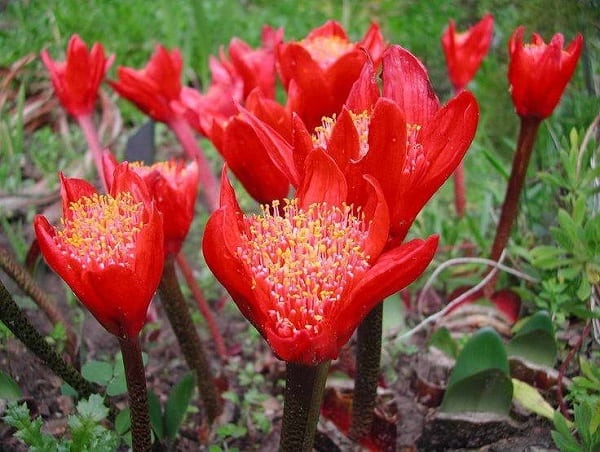

e. Sibiricas
Tubergena (E. tubergenii) is a hybrid form, larger flowering than wild erantis. Pollen and seeds do not form in the flowers of Erantis Tubergen, therefore it blooms longer than other representatives of the genus.


e. Tubergenii
There are two varieties known:
- Guinea gold - height no more than 10 cm, petals are dark with a brown tint, corolla diameter 3-4 cm;
- Glory - large flowers and dull greenish foliage.
Cilician (E. Cilicica) - in the wild, found in Greece and other countries of southern Europe. Peduncle height up to 10 cm. Flowers are large, diameter up to 4 cm. Leaves are very small. Blooms later than other spring plants. The species is frost-resistant.
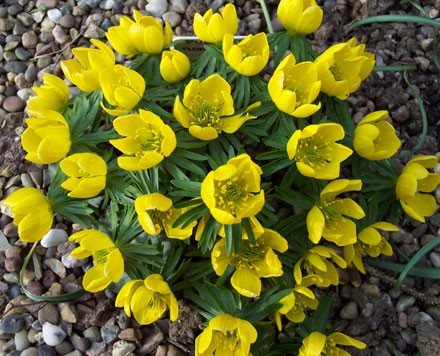

e. Cilicica
Pinnatifida (e. Pinnatifida) - white flowers with a blue-yellow center. The species is extremely unpretentious, suitable for growing in pots.
Soil composition
Flowers prefer neutral soil. Basically, gardeners have an idea of the composition of the soil in their garden plot, and those who doubt can take soil samples to the laboratory. Getting the information you need will allow you to properly grow plants in your garden.
If the soil is too acidic, lime is added. The optimal composition is considered to be loamy, rather loose. It is undesirable to plant flowers in low-lying areas, where a large amount of water will accumulate during the snow melt. An ice crust may form, making it difficult for oxygen to reach the roots. The presence of trace elements has a positive effect on erantis, especially the plant requires it during the budding period.
Spring plant propagation by seeds and nodules
Vesennik, if you do not remove faded inflorescences in a timely manner, multiplies by self-seeding. The seeds are scattered near the mother bush, undergo winter stratification and sprout amicably with the onset of spring.The grown plants are dug up and transplanted to a new place.
Experienced gardeners in the fall collect erantis seeds and immediately plant them on a pre-prepared area. In winter, the seeds will undergo stratification and germinate with the arrival of spring. The grown plants will need to be thinned out so that they are not cramped. After the young individuals get stronger and grow up, they can be transplanted to a permanent place. Blossoming of a spring plant grown in this way can be expected three years after planting.
Spring planting of seeds is also possible, but then you will need to stratify them at home by placing them in a container with wet sand and putting them in a cold place for 2 months, for example, in a refrigerator. The sand should be moistened periodically.
Seeds can be stratified in another way: plant them in small containers containing a drainage layer, a moistened mixture of peat and sand. Sprinkle the seed with peat, then cover it tightly with expanded polystyrene - a material that keeps the temperature well and remove it under the snow. In the spring, the prepared seeds can be planted in the ground.
They grow seeds and seedlings at home. To do this, take compact pots or plastic cups and fill them with potting soil for flowers. Before planting, the seeds are placed in a damp cloth and stored in the refrigerator for a week. The stratified seeds are buried by 1 - 2 cm. After planting, they are periodically watered. When young plants form 5 - 6 leaves, they are transplanted to a permanent place on the site by transferring them together with an earthen lump. After planting the seedlings of the spring plant (erantis), they are regularly looked after, this will allow insufficiently strong plants to quickly root and grow.
Two- and three-year-old plants can be propagated by nodules. This work is performed after the bush has completely bloomed and only leaf plates remain on it. The rhizome with tubers is carefully dug out of the ground, trying not to damage them, with the help of a sharp knife, the daughter tubers are separated, the cuts are sprinkled with charcoal. The separated tubers are immediately planted in a permanent place in prepared holes 6 cm deep, filled with a substrate with wood ash, humus. The holes should also be located at a distance of 10 - 15 cm from each other. You can place 3 - 5 tubers in one hole. Sprinkle the plantings with a layer of mulch.
Description of erantis and a photo of a flower at different stages of development
We offer a short description of erantis and its botanical characteristics. This little-known plant deserves close attention from gardeners.
At its core, it is a herbaceous perennial plant that has a stem length of 10-15 centimeters.
The flowers are usually yellow and will be some of the first to appear in your garden in the spring. In a mild climate, they appear already in January, and calmly survive snow covers - they are frost-resistant and easily survive in such conditions.
The leaves open up to their full potential only when the flowers are almost closed. Their diameter is no more than eight millimeters. They descend moderately, over time - until they die and hang down at the very end of winter (that is, the flowering time of erantis spring is on average two to three months). In winter, erantis usually grow from tubers.
Some varieties are ephemeral, which sit comfortably in the lower canopy of deciduous trees, where there is still access to the sun's rays.
When the shade from the crown of trees becomes very dense or a summer drought reduces the availability of water - in arid regions, as a rule, the leaves of the flower begin to die off.
Next, you can see a photo of the erantis flower at different stages of its development:
Erantis. Photo
Erantis winter - one of the earliest spring flowers
The winter erantis flower is one of the species of flowering plants of the Buttercup family, which lives on the territory of Europe in the vastness of the forest.Translated from Latin "hyemalis" means winter flowering. This tuberous herbaceous perennial grows up to 15 centimeters in length with large, cup-shaped yellow flowers with three leaf-like bracts. Like other species, flowers appear on Erantis winter in late winter or early spring. There are numerous stamens and non-condensed carpels (there are usually only six of them). Each fruit contains several seeds.
The winter variety is also popular under the name "Winter Aconite" and is rated as one of the earliest spring flowers to grow during this period.
All parts of the plant are poisonous, food is not allowed, precautions are necessary when caring for the flower.
Also known are two varieties that were bred on the basis of winter erantis and are considered its subspecies:
- winter erantis "Gold of Guinea" is distinguished by large flowers and bronze foliage;
- erantis winter "Flora Plena" has a double flower.
Well, and another photo of erantis from various angles of a flowering plant:
On the eve of warm days, as soon as the first thawed patches look out, bright clumps of erantis appear under the leafless crowns of trees - translated from Greek this name means "spring flower".
An early flowering plant of the buttercup family has 7 species. Distributed in many regions and countries. Sometimes it is called "winter aconite". A miniature, elegant, ornamental flowering plant with a tuberous-thickened rhizome of brown or black color. Tuberous growths on the roots serve as the rudiments of future plants, since the main plant sometimes dies off after flowering.
Care advice
Flowers are easy to care for for novice florists. A slight waterlogging of the soil is constantly necessary, otherwise the tubers may begin to rot. Erantis is not picky about fertilizers. Top dressing can be applied three times throughout the season. Weed weeds in a timely manner. Summer is considered a dormant period for a flower, so watering is reduced. May tolerate mild drought. It is impossible to dig up the soil so as not to damage the tubers.
After flowering, it is recommended to remove the flowers with scissors or pruning shears. Leaves must not be touched. During this period, the nutrients necessary for the tubers begin to form. For the winter, you can make a shelter from crushed bark or fallen leaves, which will protect the planting of flowers from freezing.

